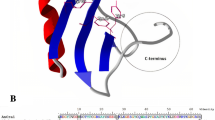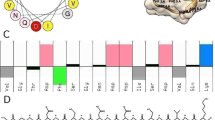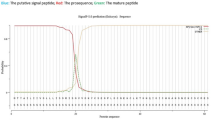Abstract
Objectives
To identify an efficient in vitro refolding method to generate highly active His6-tagged scorpion toxin antitumor-analgesic peptide (AGAP) isolated from Escherichia coli inclusion bodies.
Results
N- and C-Terminal His6-tagged recombinant (r) AGAP (NHis6-rAGAP and CHis6-rAGAP, respectively) were expressed in E. coli; the purification and refolding conditions were optimized. CHis6-rAGAP, but not NHis6-rAGAP, exhibited significant in vitro antihepatoma activity that was much greater than that of rAGAP produced using SUMO fusion technology (IC50, 0.4 ± 0.08 vs. 1.8 ± 0.3 μM). CHis6-rAGAP also showed significant inhibition of tumor growth in a mouse xenograft model of human hepatoma and inhibition of neuronal excitability, demonstrated by blockage of voltage-sensitive tetrodotoxin-resistant (TTX-R) sodium currents in acute isolated dorsal root ganglion neurons.
Conclusions
This refolding protocol optimized for C-terminal His6-tagged scorpion rAGAP is potentially applicable to similar long-chain and cysteine-rich toxins.



Similar content being viewed by others
References
Altamirano MM, Garcia C, Possani LD, Fersht AR (1999) Oxidative refolding chromatography: folding of the scorpion toxin Cn5. Nat Biotechnol 17:187–191
Balduino KN, Spencer PJ, Malavasi NV, Chura-Chambi RM, Lemke LS, Morganti L (2011) Refolding by high pressure of a toxin containing seven disulfide bonds: bothropstoxin-1 from Bothrops jararacussu. Mol Biotechnol 48:228–234
Baneyx F, Mujacic M (2004) Recombinant protein folding and misfolding in Escherichia coli. Nat Biotechnol 22:1399–1408
Cao P et al (2010) Expression and purification of an antitumor-analgesic peptide from the venom of Mesobuthus martensii Karsch by small ubiquitin-related modifier fusion in Escherichia coli. Biotechnol Prog 26:1240–1244
Estrada G et al (2007) Four disulfide-bridged scorpion beta neurotoxin CssII: heterologous expression and proper folding in vitro. Biochim Biophys Acta 1770:1161–1168
Goudet C, Chi CW, Tytgat J (2002) An overview of toxins and genes from the venom of the Asian scorpion Buthus martensi Karsch. Toxicon 40:1239–1258
Ling CQ, Yue XQ, Ling C (2014) Three advantages of using traditional Chinese medicine to prevent and treat tumor. J Integrat Med 12:331–335
Liu YF, Ma RL, Wang SL, Duan ZY, Zhang JH, Wu LJ, Wu CF (2003) Expression of an antitumor-analgesic peptide from the venom of Chinese scorpion Buthus martensii karsch in Escherichia coli. Prot Expr Purif 27:253–258
Lyukmanova EN et al (2009) Bacterial production and refolding from inclusion bodies of a “Weak” toxin, a disulfide rich protein. Biochem (Moscow) 74:1142–1149
Ma R et al (2010) Location of the analgesic domain in Scorpion toxin BmK AGAP by mutagenesis of disulfide bridges. Biochem Biophys Res Commun 394:330–334
M’Barek S et al (2003) Synthesis and characterization of Pi4, a scorpion toxin from Pandinus imperator that acts on K+ channels. Eur J Biochem 270:3583–3592
Rodriguez de la Vega RC, Possani LD (2005) Overview of scorpion toxins specific for Na+ channels and related peptides: biodiversity, structure-function relationships and evolution. Toxicon 46:831–844
Shao JH, Zhang R, Ge X, Yang B, Zhang JH (2007) Analgesic peptides in Buthus martensii Karsch: a traditional chinese animal medicine. Asian J Trad Med 2:6
Shao J, Zhao C, Hui C, Zhao R, Ruan X (2013) Molecular cloning and functional identification of analgesic peptides from Buthus martensii Karsch. Turk J Biochem 38:499–505
Windley MJ, Escoubas P, Valenzuela SM, Nicholson GM (2011) A novel family of insect-selective peptide neurotoxins targeting insect large-conductance calcium-activated K+ channels isolated from the venom of the theraphosid spider Eucratoscelus constrictus. Mol Pharmacol 80:1–13
Acknowledgments
This work was supported by grants from the National Natural Science Foundation of China (Nos. 81302694, 81473377, 81573837), the Natural Science Foundation of Jiangsu Province (BK2012492, BK20131038, BK20140049), Shanghai Municipal Natural Science Foundation (No. 13ZR1448900) and the Natural Science Foundation of Shanghai (No. 12ZR1415600).
Supporting information
Supplementary Methods: Optimization of rAGAP refolding and purification; Preparation of human hepatoma xenografts in mice and assay of antitumor activity of rAGAP in vivo.
Supplementary Table 1—Purification and recovery of CHis6-rAGAPa.
Supplementary Fig. 1—Construction of the plasmid pET29a/CHis6-rAGAP.
Supplementary Fig. 2—SDS-PAGE and HPLC analyses of expression, purification, and refolding of CHis6-rAGAP a SDS-PAGE analysis of CHis6-rAGAP expression and inclusion body preparation.
Author information
Authors and Affiliations
Corresponding authors
Additional information
Qingxin Cao and Wuguang Lu have contributed equally to this work.
Electronic supplementary material
Below is the link to the electronic supplementary material.
Rights and permissions
About this article
Cite this article
Cao, Q., Lu, W., Cai, X. et al. In vitro refolding and functional analysis of polyhistidine-tagged Buthus martensii Karsch antitumor-analgesic peptide produced in Escherichia coli . Biotechnol Lett 37, 2461–2466 (2015). https://doi.org/10.1007/s10529-015-1936-8
Received:
Accepted:
Published:
Issue Date:
DOI: https://doi.org/10.1007/s10529-015-1936-8




